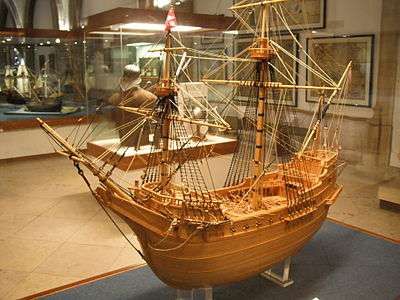Madre de Deus
Madre de Deus (Mother of God; also called Mãe de Deus and Madre de Dios) was a Portuguese ship, renowned for her fabulous cargo, which stoked the English appetite for trade with the Far East, then a Portuguese monopoly. She was returning from her second voyage East under Captain Fernão de Mendonça Furtado when she was captured.

Description
Built in Lisbon in 1589, she was 165 feet (50 m) in length, had a beam of 47 feet (14 m), measured 1,600 tons burthen, and could carry 900 tons of cargo.[1] She had seven decks, thirty-two guns in addition to other arms, 600 to 700 crew members, a gilded superstructure and a hold filled with treasure.
Capture
In 1592, by virtue of the Iberian Union, the Anglo-Portuguese Treaty of 1373 was in abeyance, and as the Anglo–Spanish War was still ongoing, Portuguese shipping was a fair target for the Royal Navy.
On 3 August 1592[2] (sources vary as to the date) a six-member English naval squadron fitted out by the Earl of Cumberland and Walter Raleigh set out to the Azores to intercept Spanish shipping from the New World when a Portuguese fleet came their way near Corvo Island.[3] The English took her after a fierce day-long battle near Flores Island in which many Portuguese sailors were killed.
Among these riches were chests filled with jewels and pearls, gold and silver coins, ambergris, rolls of the highest-quality cloth, fine tapestries, 425 tons of pepper, 45 tons of cloves, 35 tons of cinnamon, 3 tons of mace, 3 tons of nutmeg, 2.5 tons of benjamin (a highly aromatic balsamic resin used for perfumes and medicines), 25 tons of cochineal and 15 tons of ebony.[4]
There was also a document, printed at Macau in 1590, containing valuable information on the China and Japan trade; Hakluyt observes that it was "enclosed in a case of sweet Cedar wood, and lapped up almost an hundredfold in fine Calicut-cloth, as though it had been some incomparable jewel".
Aftermath
The carrack whilst at Dartmouth, England was subject to theft on an industrial scale; it attracted all manner of traders, dealers, cutpurses, and thieves from miles around. By the time Walter Raleigh had restored order, a cargo estimated at half a million pounds (nearly half the size of England's treasury and perhaps the second-largest treasure ever after the Ransom of Atahualpa) had been reduced to £140,000.
See also
Notes
- Smith, Roger (1986). "Early Modern Ship-types, 1450-1650". The Newberry Library. Archived from the original on July 20, 2008. Retrieved 2014-03-11.
- Latham & Youings 1999, p. 78
- The Gulf Stream and the Westerlies converge near the Azores, where ships coming from both areas would pass.
- An inventory was taken, and the report produced mentions "Gods great favor towards our nation, who by putting this purchase into our hands hath manifestly discovered those secret trades & Indian riches, which hitherto lay strangely hidden, and cunningly concealed from us". It also speaks of the following goods aboard, besides jewels: "spices, drugs, silks, calicos, quilts, carpets and colors, &c. The spices were pepper, cloves, maces, nutmegs, cinnamon, greene, ginger: the drugs were benjamin, frankincense, galingale, mirabilis, aloes zocotrina, camphire: the silks, damasks, taffatas, scarceness, alto bassos, that is, counterfeit, cloth of gold, unwrought China silk, sleeved silk, white twisted silk, curled cypresse. The calicos were book-calicos, calico-launes, broad white calicos, fine starched calicoes, course white calicos, brown broad calicos, brown course calicos. There were also canopies, and course diapertowels, quilts of course sarcenet and of calico, carpets like those of Turky; whereunto are to be added the pearl, muske, civet, and amber-griece. The rest of the wares were many in number, but less in value; as elephants teeth, porcelain vessels of China, coco-nuts, hides, ebenwood as black as jet, bested of the same, cloth of the rind’s of trees very strange for the matter, and artificial in workmanship".
References
- Latham, Agnes; Youings, Joyce (1999). The Letters of Sir Walter Raleigh. Exeter: University of Exeter Press. p. 78.CS1 maint: ref=harv (link)
- Landes, David Saul (1999). The Wealth and Poverty of Nations: Why Some Are So Rich and Some So Poor. W. W. Norton & Company. ISBN 0-393-31888-5.
External links
- Rogério Miguel Puga (December 2002). "The Presence of the "Portugals" in Macau and Japan in Richard Hakluyt's Navigations" (PDF). Bulletin of Portuguese/Japanese Studies. 5: 81–116. Archived (PDF) from the original on February 5, 2012. Cite journal requires
|journal=(help)